

Python. Python Tutorial — Python v2.6.4. Python is an easy to learn, powerful programming language. It has efficient high-level data structures and a simple but effective approach to object-oriented programming. Python’s elegant syntax and dynamic typing, together with its interpreted nature, make it an ideal language for scripting and rapid application development in many areas on most platforms.
The Python interpreter and the extensive standard library are freely available in source or binary form for all major platforms from the Python web site, and may be freely distributed. The same site also contains distributions of and pointers to many free third party Python modules, programs and tools, and additional documentation. The Python interpreter is easily extended with new functions and data types implemented in C or C++ (or other languages callable from C). This tutorial introduces the reader informally to the basic concepts and features of the Python language and system. Dive Into Python. Scripting Your .Net Applications with IronPython. One of the major use cases for IronPython is embedding in .NET applications to provide user scripting.
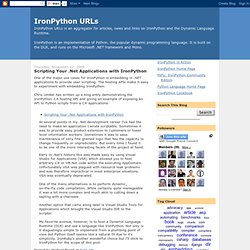
The hosting APIs make it easy to experiment with embedding IronPython. Chris Umbel has written up a blog entry demonstrating the IronPython 2.6 hosting API and giving an example of exposing an API to Python scripts from a C# applications. Scripting Your .Net Applications with IronPython At several points in my .Net development career I've had the need to make an application I wrote scriptable. Sometimes it was to provide easy product extension to customers or lower level information workers. Early in .Net's history this was made easy by using Visual Studio for Applications (VSA) which allowed you to host arbitrary C# or VB.Net code within the executing AppDomain. Variable sharing between C# and iron python. Extending your C# application with IronPython - berniea. Recently I’ve started messing around with IronPython; IronPython is the first language of a set of languages that rely on the DLR (Dynamic Language Runtime), the DLR is a hosting platform and a dynamic type system, capable of running dynamic languages on top of the CLR.
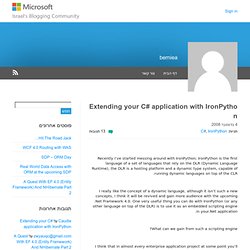
I really like the concept of a dynamic language, although it isn’t such a new concepts, I think it will be revived and gain more audience with the upcoming .Net Framework 4.0. One very useful thing you can do with IronPython (or any other language on top of the DLR) is to use it as an embedded scripting engine in your.Net application. What can we gain from such a scripting engine? I think that in almost every enterprise application project at some point you’ll come to the conclusion that you need extension points in the system. It can be a Rule Engine, a Workflow of some sort or a pluggable User Interface. Using IronPython in WPF to Evaluate Expressions. Download demo application which includes everything - 2.08 MB Introduction For those who follow my articles, you may have expected a new one in my MVVM series, don't worry that is on its way very soon, but there is always time for a little article.
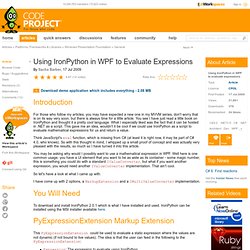
Embedding IronPython in a C# Application. Download source - 13.96 KB Introduction This article (and the code) demonstrates how to use the IronPython engine inside of a C# Windows Form application.
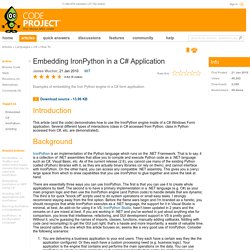
Introducing IronPython. Jim was shocked to discover that his two-week effort resulted in a Python implementation that ran faster than Jython.
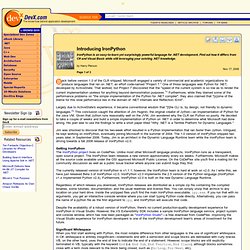
Intrigued, he kept working on IronPython, eventually joining Microsoft in the summer of 2004. The 1.0 version of IronPython shipped two years later, in September 2006. Today, Jim is an architect in the Dynamic Language Runtime team while the IronPython team is driving towards a fall 2008 release of IronPython v2.0. Getting IronPython The IronPython project lives on CodePlex. Unlike most other Microsoft language products, IronPython runs as a transparent, open source project. The currently released version of IronPython is v1.1.1; however, the IronPython team is hard at work on v2.0.
Regardless of which release you download, IronPython releases are distributed as a simple zip file containing the compiled binaries, some tutorials, documentation, and the usual readmes and license files. A 3 minute guide to embedding IronPython in a C# application. 'Steven Nagy' on Thu, 05 Mar 2009 19:33:10 GMT, sez: Interesting...

(the IronPython integration that is, not this article). Now we can embed Quake2 style console popdowns in all our applications. 'tarn' on Thu, 05 Mar 2009 23:36:03 GMT, sez: That's fantastic, but the fun has only just begun! Import clr. Embedding IronPython – C# Calling Python Script Part 1. Getting Started with IronPython. I recently spent some time getting IronPython up and running on my system; I will review what I learned in this post.
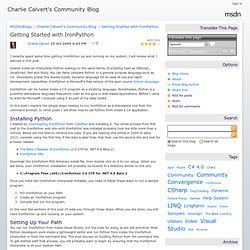
Hosted inside an interpreter, Python belongs to the same family of scripting tools as VBScript, JavaScript, Perl and Ruby. You can fairly compare Python to a general purpose language such as C#. Developers praise this loosely typed, dynamic language for its ease of use and rapid development capabilities. CLR Inside Out: IronPython. CLR Inside Out IronPython James Schementi IronPython is the code name for an implementation of the Python programming language written by the CLR team at Microsoft.

IronPython runs on the Microsoft® .NET Framework and supports an interactive console with fully dynamic compilation. It is well integrated with the rest of the .NET Framework and makes all .NET libraries easily available to Python programmers, while maintaining full compatibility with the Python language. This column will give a brief overview of Python and what sets dynamic languages apart from other languages. Dynamic Languages and Iterative Development Dynamic programming languages allow for a program's structure to be changed while it runs: functions may be introduced or removed, new classes of objects may be created, and new modules may appear.
Here's an example of the Python function fib, which computes the Fibonacci numbers up to the specified value of n: So how are dynamic languages able to achieve this? Line Noise.